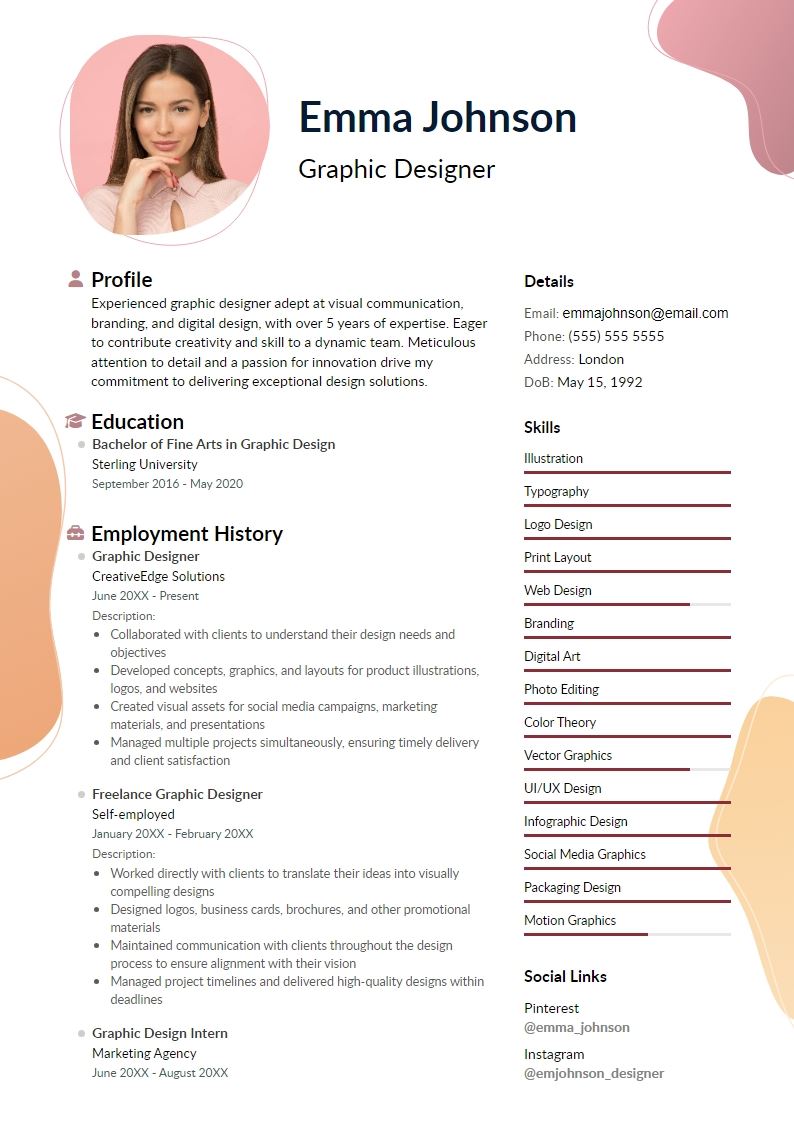Graphic Designer Resume Example
How to Write a Graphic Designer Resume
In today's competitive job market, a well-crafted resume is essential to stand out as a graphic designer. Your resume serves as a visual representation of your skills, creativity, and professionalism. To help you create an impactful resume that lands you your dream job, here are some tips and tricks to consider:
-
Tailor Your Resume to the Job Description: Before you start writing your resume, carefully review the job description and highlight the key skills and qualifications required. Customize your resume to showcase how your experience and abilities align with the specific needs of the employer.
-
Choose the Right Format: As a graphic designer, your resume should reflect your creativity while maintaining professionalism. Consider using a clean and visually appealing layout that highlights your design skills. Formats such as infographic resumes or portfolios can be effective in showcasing your work.
-
Highlight Your Skills: Include a dedicated section to showcase your technical skills, software proficiency, and design expertise. Be specific about the tools and software you are proficient in, such as Adobe Creative Suite (Photoshop, Illustrator, InDesign), typography, illustration, and web design.
-
Showcase Your Portfolio: Your portfolio is a crucial component of your resume as a graphic designer. Provide a link to your online portfolio or attach a selection of your best work samples that demonstrate your range and creativity. Make sure your portfolio is well-organized and easy to navigate.
-
Quantify Your Achievements: Instead of simply listing your job responsibilities, quantify your achievements wherever possible. For example, mention the percentage increase in website traffic due to a successful branding campaign or the number of social media followers gained from your graphic designs.
-
Use Action Words: Start each bullet point with action verbs to make your resume more dynamic and engaging. Words like "designed," "created," "implemented," and "collaborated" demonstrate your proactive approach and contributions to projects.
-
Include Relevant Experience: Prioritize relevant work experience that demonstrates your proficiency in graphic design. If you're a recent graduate or transitioning into graphic design from another field, include internships, freelance projects, or volunteer work that showcases your skills.
-
Keep it Concise: While it's essential to provide comprehensive information about your skills and experience, keep your resume concise and focused. Aim for a one-page resume whenever possible, focusing on the most relevant information.
-
Proofread and Edit: Before submitting your resume, carefully proofread it for typos, grammatical errors, and formatting inconsistencies. Ask a friend or colleague to review your resume to ensure clarity and professionalism.
-
Update Regularly: Keep your resume up-to-date with your latest skills, experiences, and achievements. As you gain new skills or complete notable projects, make sure to incorporate them into your resume to reflect your ongoing growth and development as a graphic designer.
In conclusion, a well-crafted graphic designer resume is essential for showcasing your skills, experience, and creativity to potential employers. By following these tips and tricks, you can create a resume that effectively highlights your strengths and sets you apart in the competitive job market. Good luck!
